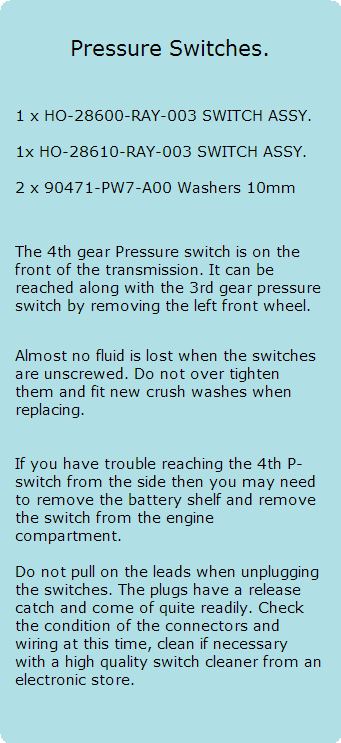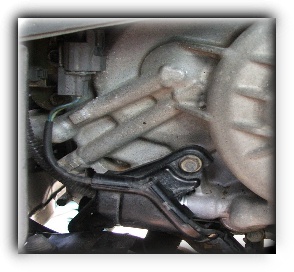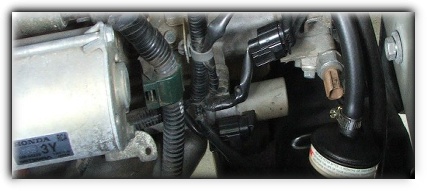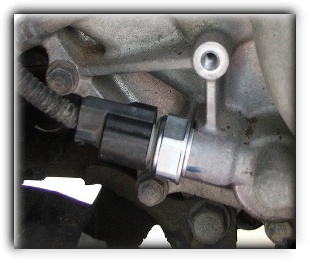
History: Gen7 V6 5AT. There was a lot of talk on various forums concerning possible faults these can cause when they go out of tolerance. I've seen two transmissions rebuilders recommend replacing them every 5 years or so as part of a preventive measure. Apparently to help prevent clutch pack damage. Quoted rational was that as they age they signal the PCM to extend the lockup time or transition time between gears and therefore would result in excessive wear and heat. There were a few of reports of harsh shifting, vague shifting, vibrating roughness when shifting and very slow engagement from P-D or N-D being reduced by their replacement.
I initially had two questions with a few of the reports: 1 - Quite often the battery is disconnected and/or some or all of the fluid is replaced when these pressure switches are replaced. Doing this has been shown to temporally mask or sometimes reduce these same conditions. 2 - These switches are two of many logic inputs that the TCU uses to adjust clutch overlap pressure and shift timing on most gear shifts - how and when?
After hounding a few of the Honda parts outlets it appears that the 3rd gear pressure switch is a commonly ordered item at some dealers. Nothing much in itself but at the time it made me look further.
I could see a case where, over time, you may not notice shifts from 2nd to 3rd, 3rd to 4th and 4-3, 3-2 getting slower or less crisp, it was this possibility that interested me at the time as 3rd is the clutch pack that fails more often than most. So with that in mind I decided to test and replace them.
I initially had two questions with a few of the reports: 1 - Quite often the battery is disconnected and/or some or all of the fluid is replaced when these pressure switches are replaced. Doing this has been shown to temporally mask or sometimes reduce these same conditions. 2 - These switches are two of many logic inputs that the TCU uses to adjust clutch overlap pressure and shift timing on most gear shifts - how and when?
After hounding a few of the Honda parts outlets it appears that the 3rd gear pressure switch is a commonly ordered item at some dealers. Nothing much in itself but at the time it made me look further.
I could see a case where, over time, you may not notice shifts from 2nd to 3rd, 3rd to 4th and 4-3, 3-2 getting slower or less crisp, it was this possibility that interested me at the time as 3rd is the clutch pack that fails more often than most. So with that in mind I decided to test and replace them.



Remove two bolts holding the protective cover (shown on the left). The 3rd gear P-switch is underneath this cover. The wiring for the ATF temperature sensor runs through the cover, don't force the cover around. The hardest part is getting the wiring connector for the ATF temperature sensor apart. This must be undone before the protective cover can be safely moved to one side
The 4th gear P-switch is located below the battery and low towards the chassis rail.
It's the Tan coloured device in the picture; the lead has been unplugged from the end for a better view of the switch.
It's the Tan coloured device in the picture; the lead has been unplugged from the end for a better view of the switch.
Three friends have Honda G7's; I have a G6 and a G7 and have been paying particular attention to how mine and the others shift under all conditions over the past 12 months. There are two things that feel slightly out of place. They have a slightly longer shift overlap from 2nd to 3rd when cold and driven like a Granny on Sunday mornings (no flaring) Like a feeling that DBW is holding the throttle back slightly longer almost like a slight bind between gears. The slightest ease up of the accelerator and the DBW position sensor signals the TCU to make 2nd to 3rd shift complete almost instantly. No harshness at anytime and all shifts under slow, normal or flat-out hard driving are fine. To me it feels like it’s trying to make the 2nd to 3rd shift as smooth as possible for that style of Granny driving.
The second quirk is a slight delay when shifting from P to D. These V6 transmissions engage two clutch packs sequentially when shifting from N to D so that 1st gear is gently engaged, unlike the transmissions I’m used to that just select 1st. There are a lot of posts on various forums about this delay, most report a slight delay but quite a few are taking over 3 seconds which may be a problem and an obvious fault, the design time is around 2 seconds for the complete lockup of the 1st clutch.
This engagement time is just under 1.6 second (now confirmed as normal engagement time) from cold and shorter when warm. The other Hondas of this age I have driven were the same or longer in this engagement. I only noticed it because I went looking for it after reading forums, never noticed mine until then. I regularly drive four different cars (2 not Honda) and this G7 transmission feels more responsive that the others.
After changeing the P-switches I noticed a change in the way 4th responds at speeds below 40mph. Prior to changing 3rd and 4th P-switches, 3rd to 4th shifts were difficult to feel and 4th shifted through quite quickly, now it holds longer in 4th and the change into 4th is crisp and noticeable. The 2-3 granny shift has been eliminated - huge differance. To recap - all shifts into and through all gears now have a consistent feel. Some of these changes are things that the average driver may not really notice but they are important nevertheless.
The manual gives a vague outline of changes in shift feel and RPM shift points when discussing cold versus warm operation however, I felt the throttle was still being held back a little to much on 2-3 shifts, especially cold, it was slightly different to 1-2 and 3-4 cold shifts and I noticed it, just as I noticed the duration of time in 4th at low speed and light loads. Since the P-switch change I feel these are back to what I expected from both cold and warm trans oil and engine temperature operation.
I decided to reset the ECU-TCU a few days ago to see if it behaved differently than with past resets. Previous resets have made very little difference, apart from an expected change in fuel economy and, I feel, a slightly improved throttle response. Now I feel noticeable differences around 2-3 and 3-4, the shifts were even firmer (love it) but slowly returned to that pre-reset feeling after a day of driving. It seems like the ECU-TCU is programmed to make the transmission shifts as smooth as possible and the engine as fuel efficient as possible, even with spirited driving during the recalibration/learn period. That is a common complaint with enthusiasts.
UPDATE: Changing these P-switches will reduce transmission wear. In my case, because of the way “both” these switches had drifted, it appears timing was slightly off as I noticed a change in both gears that rely on these P-switches. The second vehicle noticed a change in 2-3 shifts when cold and a slight reduction in warm N - D engagement time. A third vehicle noticed no real change and he’s not happy. His transmission does not shift as nicely as mine, just feels a bit vague. It’s an earlier model though with much higher mileage and a replacement transmission a few years back, so maybe a different TCU-ECU program, other internal wear, luck of the draw who knows.
It’s not the internal switch contacts that are the problem, it’s the mechanism for sensing the correct pressure for switch closure that appears to change with heat and age. The workshop manual glosses over these and a reference to them reads - "Pressure switches 3 and 4 - Correction of hydraulic pressure and application timing" These pressure switches are included in a list of possible causes for - "Excessive shock or flares on 2-3 up-shifts or 3-2 downshifts and 3-4 up-shifts or 4-3 downshifts". This appears to do with a P-switch orifice being blocked. As the TCU can generate codes P0847/48 and P0872/73 for the P-switches being stuck on/off (and D Indicator blinks), I assume a partial blockage is being referred to here?
Updated. Clutch pack life is affected when these sensors drift even a few PSI - no code will be set. Out of tolerance operation of these pressure sensors will cause unnoticed clutch pack wear (Now Proven). The pressure in the clutch packs at full engagement is above 120psi and these sensors require only 27-33 psi to activate, The sensors are used to signal when the clutch pressure has bled down to this level and are above this preset level. Replace them every 50,000 miles or 3 to 5 years.
New information now confirms how vital these P-switches are to 3rd clutch pack life. SEE Pressure switch UPDATE.
The second quirk is a slight delay when shifting from P to D. These V6 transmissions engage two clutch packs sequentially when shifting from N to D so that 1st gear is gently engaged, unlike the transmissions I’m used to that just select 1st. There are a lot of posts on various forums about this delay, most report a slight delay but quite a few are taking over 3 seconds which may be a problem and an obvious fault, the design time is around 2 seconds for the complete lockup of the 1st clutch.
This engagement time is just under 1.6 second (now confirmed as normal engagement time) from cold and shorter when warm. The other Hondas of this age I have driven were the same or longer in this engagement. I only noticed it because I went looking for it after reading forums, never noticed mine until then. I regularly drive four different cars (2 not Honda) and this G7 transmission feels more responsive that the others.
After changeing the P-switches I noticed a change in the way 4th responds at speeds below 40mph. Prior to changing 3rd and 4th P-switches, 3rd to 4th shifts were difficult to feel and 4th shifted through quite quickly, now it holds longer in 4th and the change into 4th is crisp and noticeable. The 2-3 granny shift has been eliminated - huge differance. To recap - all shifts into and through all gears now have a consistent feel. Some of these changes are things that the average driver may not really notice but they are important nevertheless.
The manual gives a vague outline of changes in shift feel and RPM shift points when discussing cold versus warm operation however, I felt the throttle was still being held back a little to much on 2-3 shifts, especially cold, it was slightly different to 1-2 and 3-4 cold shifts and I noticed it, just as I noticed the duration of time in 4th at low speed and light loads. Since the P-switch change I feel these are back to what I expected from both cold and warm trans oil and engine temperature operation.
I decided to reset the ECU-TCU a few days ago to see if it behaved differently than with past resets. Previous resets have made very little difference, apart from an expected change in fuel economy and, I feel, a slightly improved throttle response. Now I feel noticeable differences around 2-3 and 3-4, the shifts were even firmer (love it) but slowly returned to that pre-reset feeling after a day of driving. It seems like the ECU-TCU is programmed to make the transmission shifts as smooth as possible and the engine as fuel efficient as possible, even with spirited driving during the recalibration/learn period. That is a common complaint with enthusiasts.
UPDATE: Changing these P-switches will reduce transmission wear. In my case, because of the way “both” these switches had drifted, it appears timing was slightly off as I noticed a change in both gears that rely on these P-switches. The second vehicle noticed a change in 2-3 shifts when cold and a slight reduction in warm N - D engagement time. A third vehicle noticed no real change and he’s not happy. His transmission does not shift as nicely as mine, just feels a bit vague. It’s an earlier model though with much higher mileage and a replacement transmission a few years back, so maybe a different TCU-ECU program, other internal wear, luck of the draw who knows.
It’s not the internal switch contacts that are the problem, it’s the mechanism for sensing the correct pressure for switch closure that appears to change with heat and age. The workshop manual glosses over these and a reference to them reads - "Pressure switches 3 and 4 - Correction of hydraulic pressure and application timing" These pressure switches are included in a list of possible causes for - "Excessive shock or flares on 2-3 up-shifts or 3-2 downshifts and 3-4 up-shifts or 4-3 downshifts". This appears to do with a P-switch orifice being blocked. As the TCU can generate codes P0847/48 and P0872/73 for the P-switches being stuck on/off (and D Indicator blinks), I assume a partial blockage is being referred to here?
Updated. Clutch pack life is affected when these sensors drift even a few PSI - no code will be set. Out of tolerance operation of these pressure sensors will cause unnoticed clutch pack wear (Now Proven). The pressure in the clutch packs at full engagement is above 120psi and these sensors require only 27-33 psi to activate, The sensors are used to signal when the clutch pressure has bled down to this level and are above this preset level. Replace them every 50,000 miles or 3 to 5 years.
New information now confirms how vital these P-switches are to 3rd clutch pack life. SEE Pressure switch UPDATE.

Some so called experts (Honda dealers and others) claim that these switches are simple on/off switches and therefore won't cause a problem without throwing a code.
Well yes, this type of pressure switch is a simple mechanical device, but NO, the on/off status has nothing to do with the operational problem with these switch's. Because of their construction they MUST and WILL drift out of specification - no if's, no buts, no maybes.
They still open / close as before and therefore will not set a code, but they switch at the WRONG pressure and you won't notice a small drift until it's too late, in other words until your clutch packs - especially 3rd - have been slowly damaged over time.
If so called experts claim P-switches are not a problem - Consider this:
A: There's around 6 PSI between new 3rd and 4th P-switch on/off-pressure points.
B: Honda and transmissions techs, those who actually work and understand Honda shift logic, WARN you to be careful and NEVER accidently swap P-switch positions around as can cause harsh shifts, clutch pack slippage or binding and damage to the transmission (if left to long), as has been proven by owners and rebuilders the hard way.
C: P-switches can drift from calibration by 7 PSI or more as they age, BUT in the WRONG direction (higher pressure) and somehow this is ok - not a problem - according to some so called experts (Honda dealers and a few transmission rebuilders), really?
Well yes, this type of pressure switch is a simple mechanical device, but NO, the on/off status has nothing to do with the operational problem with these switch's. Because of their construction they MUST and WILL drift out of specification - no if's, no buts, no maybes.
They still open / close as before and therefore will not set a code, but they switch at the WRONG pressure and you won't notice a small drift until it's too late, in other words until your clutch packs - especially 3rd - have been slowly damaged over time.
If so called experts claim P-switches are not a problem - Consider this:
A: There's around 6 PSI between new 3rd and 4th P-switch on/off-pressure points.
B: Honda and transmissions techs, those who actually work and understand Honda shift logic, WARN you to be careful and NEVER accidently swap P-switch positions around as can cause harsh shifts, clutch pack slippage or binding and damage to the transmission (if left to long), as has been proven by owners and rebuilders the hard way.
C: P-switches can drift from calibration by 7 PSI or more as they age, BUT in the WRONG direction (higher pressure) and somehow this is ok - not a problem - according to some so called experts (Honda dealers and a few transmission rebuilders), really?










